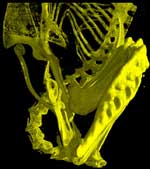The imagery on this page is the basis for a paper entitled Massive, Solidified Bone in the Wing of a Volant Courting Bird, by K.S. Bostwick, M.L. Riccio and J.M. Humphries (2012, Biology Letters, 8, 760-763). The abstract is as follows:
One pervasive morphological feature of tetrapods is the pipe-like, often marrow-filled, structure of the limb or long bones. This ‘hollow’ form maximizes flexural strength and stiffness with the minimum amount of bony material, and is exemplified by truly hollow (air-filled), or pneumatic, humeri in many modern birds. High-resolution microCT scans of the wings of two male club-winged manakins (Machaeropterus deliciosus) uncovered a notable exception to the hollow-tube rule in terrestrial vertebrates; males exhibited solidified ulnae more than three times the volume of birds of comparable body size, with significantly higher tissue mineral densities. The humeri exhibited similar (but less extreme) modifications. Each of the observed osteological modifications increases the overall mass of the bone, running counter to pervasive weight-reducing optimizations for flight in birds. The club-winged manakin is named for a pair of unique wing feathers found in adult males; these enlarged feathers attach directly to the ulna and resonate to produce a distinctive sound used in courtship displays. Given that the observed modifications probably assist in sound production, the club-winged manakin represents a case in which sexual selection by female choice has generated an ecologically ‘costly’ forelimb morphology, unique in being specialized for sound production at a presumed cost in flight efficiency.

About the Species
This specimen was collected from El Placer, 24 km WNW of Lita, on Quito-San Lorenzo RR, Esmeraldas, Ecuador by Richard Prum on 30 June 1985. It was made available to The University of Texas High-Resolution X-ray CT Facility for scanning by Dr. Kim Bostwick of Cornell University and Dr. Timothy Rowe of the Department of Geological Sciences, The University of Texas at Austin. Funding for scanning was provided by a National Science Foundation Digital Libraries Initiative grant to Dr. Rowe.

About this Specimen
This whole specimen was scanned by Matthew Colbert on 12 April 2004 along the coronal axis for a total of 1305 slices. Each 1024x1024 pixel slice is 0.0602 mm thick, with an interslice spacing of 0.0602 mm and a field of reconstruction of 26 mm. The tip of the beak was clipped from the field of view.

About the
Scan
Literature
& Links
 |
Click on the thumbnail to the left for a false-color cutaway animation (5.0 mb) of the thorax of Machaeropterus. Bone density increases from yellow to green to red. |
 |
Click on the thumbnail to the left for a roll animation (3.3 mb) of the thorax of Machaeropterus. The humerus is aqua, the radius is orange, the ulna is yellow, and the rest of the forelimb is pink. |

Additional Imagery
 |










